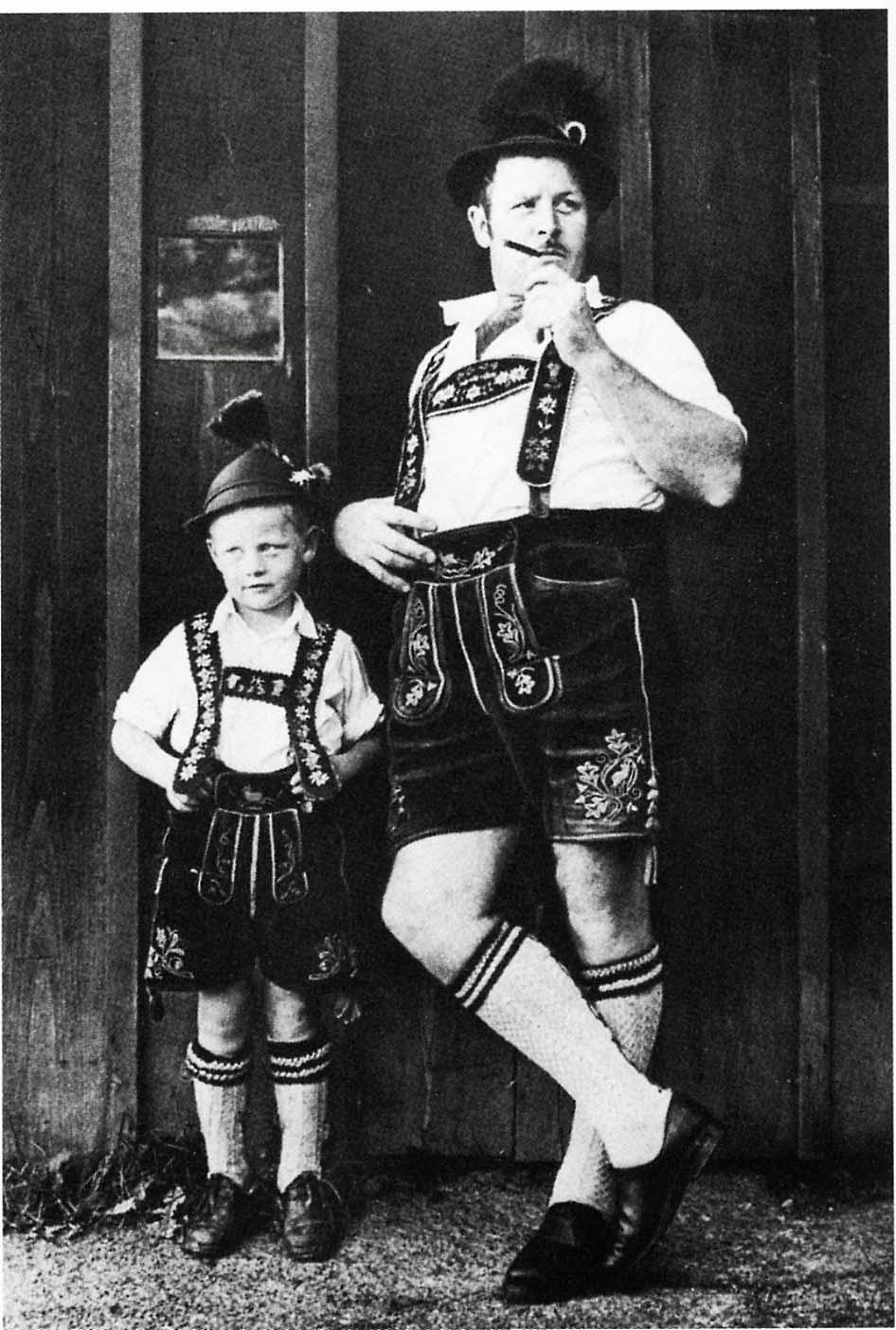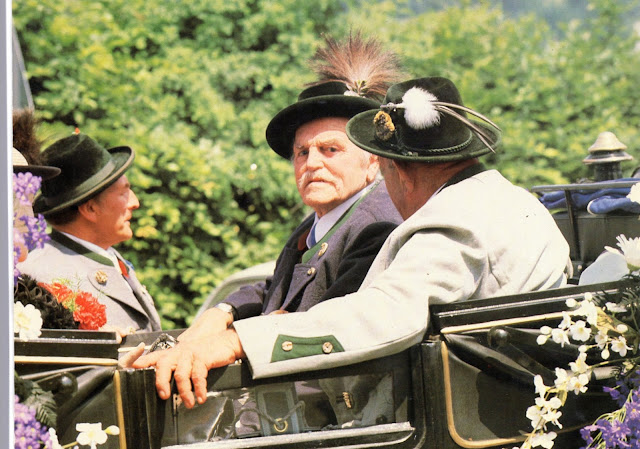Hello all,
Today I will talk about the Men's costume of Miesbach and Upper Bavaria. The impression exists that this is the typical costume of the German male, but in fact, this costume is native to just a narrow strip of mountainous territory along the southern edge of Upper Bavaria, next to the Tyrol.The costume was picked up by aristocratic men who enjoyed hunting in the mountains, because of the romantic image it conveyed and the practicality of it. Thus the lederhosen became the ideal of the Germanic free and lusty woodsman. It has since spread to the lowland city of Munich, the rest of Upper Bavaria, and has become a symbol of Germany as a whole. Lederhosen are also worn in Austria, especially the Tyrol, but not, as commonly thought, in Switzerland.
The word lederhosen simply means 'leather pants'. Leather knickers are part of the traditional wear of men over a very large area, from Sweden down to Slovenia. Lederhosen is usually understood to refer to short pants with a flap front which have decorated suspenders. This is obviously a summer costume. Full length knickers with long stockings are worn in the winter.
Here again is my friend Orest to model the Miesbach version.
The most informal version of this costume consists simply of a shirt, the lederhosen with suspenders, a belt, stockings, shoes, a hat and possibly a tie.
The shirt as worn today differs very little from a modern men's shirt. It usually has a fold down collar, is white for dress but may be plaid for every day. It traditionally buttons only partway down the front, and is pulled over the head. If very dressy, it may have a bit of embroidery on the front below the opening placket.
For everyday or less dressy occasions the shirt is often checked or gingham.
The lederhosen themselves are, of course, the heart of the costume. They are made of many types of leather, goat, cow, etc., but the most favored is staghide. The outside of the leather is turned to the inside of the pants, and has a soft finish. Many types of embroidery are used on the flap front, the side opening and seam, and the side pocket. Often the center back of the waistband is laced up, making the waistline somewhat adjustable. The leather is often black or dark green when new, but these garments are usually worn for many years, and the color lightens and the leather develops a patina.

A wide belt may be worn when the vest is not. In the Tyrol, the vest may be worn under the suspenders and the belt. There is often a lozenge shaped wider piece in front. This belt is often highly embroidered, not uncommonly with feather quillwork, but other techniques are also used.
Suspenders, hosentraeger, are always worn with lederhosen. Very often the crosspiece on the chest is a focus for ornamentation, which may include horn plates or buttons and embroidery. Sometimes the lower part of the suspenders may have a third strap which attaches in the middle. There are other regions where separate braces are worn, and often the individual straps are embroidered with beads, cross stitch, or other techniques. See the above images for examples.
In Werdenfels, just to the west of Miesbach, the suspenders are ornamented with Berlin Work Embroidery. The image at the head of the article shows this variant.
There is a pocket on the side of the lederhosen. This was traditionally used to carry a set of cutlery for use when eating away from home. This is an old tradition from the Middle Ages when forks and such were expensive, and if you were invited to eat at someone else's home, you were expected to bring your own. Today, only a knife is worn in this pocket, a very useful and practical tool for a man to carry around with him.
For more dressy occasions a silk tie, usually in red or blue is worn, with either a pin or a ring, schuber, holding it in place. The ring may be silver, or carved from horn or antler.
In the modern Miesbach costume a vest may be worn with this outfit. It is worn over the suspenders. It is usually green with red piping, and in the modern form is cut low on the chest, which shows off the embroidery on the suspenders and the tie.
Often a silver chain is hung on the lapels, and a watch chain is hung between the pockets. The first chain may have small ornaments on it, usually coins, while the larger chain often has various larger ornaments, including coins, roe deer antlers, grouse feet, bear claws, chamois horns, etc. A man will add to his collection throughout his lifetime, such ornaments often being given as gifts. The cost of such a collection will be considerable. Generally, if the vest is worn the large wide belt is not.
A couple of jackets, joppe, may be worn with this outfit. The one proper to Miesbach itself is this one. It is made of gray loden with horn buttons, a fold over lapel and ornamental topstitching in dark green. The jacket may be worn with or without the vest.
Another version is the Otterfinger joppe. This has contrasting lapels and cuffs of dark green.
Yet another jacket is the Tergenseer Joppe, which is all dark.
As you can see above, knee socks are worn with the lederhosen, often gray with dark green ornament either knitted in, and/or embroidered on. Sometimes the socks are made in two pieces, one covering just the foot, and the upper parts covering only the calf muscles. Heavy leather shoes are worn, in a couple different styes. The taller shoes, shown here are called stieferschuhe.
Shorter shoes, halbschuhe, are also worn.
Dark green felt hats are worn, often shaped rather like a fedora with twisted wool bands and tassels hanging from the back. Pins may be affixed to it, and usually one large ornament is worn. Here is a tuft of hair from chamois, called gamsbart. The longer the tuft, the more expensive, as only a few hairs on any chamois are longer than usual.
Here is an ornament made from the feathers of the Darter, or Anhinga, called in German the schlanghalsvogel.
Other common ornaments include the feathers of black grouse, capercaillie, etc, as well as flowers and other items.
These men are from Hohenaschau, which is indicated by the shape of their hats. Several locations have such identifiable hats
The above refers to dress outfits. Everyday wear is similar, but quite a bit plainer.
In colder weather the lederhosen are exchanged for kniehosen, or knickers. Here is an example of everyday winter dress. In this case, the knickers are also leather.
The knickers may also be made of loden cloth.
Long pants may also be worn with this outfit.
Such long pants are also part of the regular Miesbach outfit in times of mourning, which are considered to be more appropriate.
One more outfit began to be popular at the end of the 19th century for more formal occasions. This is called the Hochzeiter, and more closely resembles urban fashions of the time. Some men still wear this for formal occasions, but the dress Miesbach outfit is also commonly worn for weddings and such.
For cold weather either a long coat, Lodenmantel, or a cape like mantle, Jagamantel, may be worn.
I will close with some more images of this costume from many places.
Thank you for reading, I hope that you have found this to be interesting and informative.
Roman K.
email: rkozakand@aol.com
Source Material:
http://de.wikipedia.org/wiki/Miesbacher_Tracht
Many thanks to Orest and Sara and the Omaha German American Club.
Toni Demmelmeier and Torsten Gebhard, 'Trachten in Bayern, heft 1, Miesbach', Munich, 1981
Albert Kretschmer, 'Das Grosse Buch der Volkstrachten',
H Goppel et al, 'Bayrisch Land - Bayrisch Gwand, Chiemgau 1976
Franz Grieshofer, 'Die Lederhose', Husum, 1996
Irmgard Gierl, 'Miesbacher Trachtenbuch', Neu Ulm, 1971
Paul Ernst Rattelmueller, 'Volkstrachten in Bayern', Munich, 1984
















































































